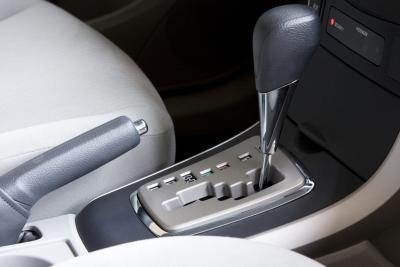
An automatic transmission is a sealed component that should never lose fluid. Some transmission fluid might need to be added from time to time due to evaporation through normal usage. The fluid might also need to be changed if it is burned or otherwise discolored. Otherwise, no transmission fluid should ever have to be added. Before troubleshooting your vehicle for fluid loss, check the fluid levels by reading the automatic transmission's dipstick.
Check the fluid level on your vehicle's automatic transmission with the transmission dipstick. Remove the dipstick, wipe it off with a rag, then reinsert and remove it once again. The fluid should be full. If it is well below the "full" line, you probably have a leak in the transmission.
Look for liquid beneath the car's engine on your parking surface. Place a piece of light colored paper or cardboard beneath the area of the transmission and let it sit in that position overnight. If you see drops in the morning, examine the fluid. If the fluid is red (or in some cases, green), the transmission is leaking fluid.
Jack up the vehicle and place at least two jack stands beneath the frame to support it. Look up at the transmission area to see if there is any leaking. Leaking pan gaskets and torque converter gaskets are common causes of transmission fluid leaks. If the leak is serious enough, the sides of these areas can be wiped off with a rag to determine if there is any fresh leaking from specific gaskets.
Inspect the filler tube sides where the tube enter the automatic transmission. Filler tube gaskets that are bad will leak at the exact point where the tube enters the transmission. In some cases, the filler tube can become dislodged. If so, grasp it firmly and push it back into place. This will stop the leak.
Pour in automatic transmission sealer if a leak is found. There is no guarantee this will work. But if it does seal up the leak, it will save you a trip to a service shop.